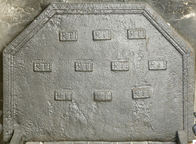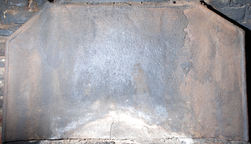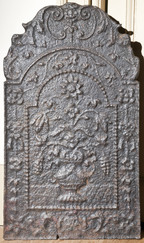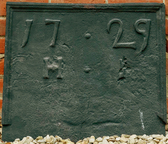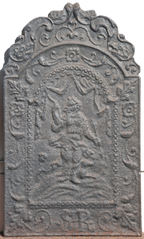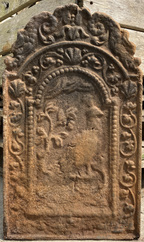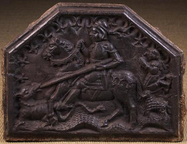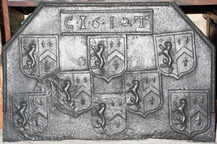-
876
Description: Canted rectangle; complex moulded edging (top and sides); rectangular incised initial stamp repeated ten times 3-4-3.
Notes: The use of an incised stamp is uncommon.
Inscription: RTI [repeated 10 times]
- Decoration tags:
- rectangular with canted top corners (shape)
- complex individual (edging)
- carved stamps
- text
Manufactured: in the 17th century in England.
Current location: Westwood Manor, Bradford-on-Avon, Wiltshire, England.
Museum number: 222509.1 (part of the National Trust museum group)
- Attached to series:
- Initials only firebacks
- Miscellaneous stamp firebacks
-
65
Description: Canted rectangle; twisted rope edging; plain plate
- Decoration tags:
- rectangular with canted top corners (shape)
- rope (edging)
- simple stamps
Manufactured: in the 16th or 17th century possibly in the Weald area of England.
Current location: in private hands, Fernhurst, West Sussex, England.
- Attached to series:
- Base boards
-
1117
Description: Arched rectangular shaped central panel, bead edging, narrow-necked urn with swagged decoration and gadrooned base, flowers issuing therefrom; arched rectangular shaped border with fillet edging and symmetrical floral festoons; on top, mirrored plant fronds descending from a small mask; at the bottom, an indistinct cartouche and a probable letter 'W' between swirled foliage.
Notes: Small firebacks of this type and period might have been cast at one of the London foundries and used for attaching to the rear of dog grates. The initial 'W' probably denotes the pattern maker.
Inscription: W
Manufactured: in the late-17th to early-18th century possibly in the London area of England.
Current location: in private hands, Isleworth, London, England.
- Attached to series:
- British 'Dutch' style firebacks
- W series
-
1241
Description: Rectangular shape; ovolo-moulded edging (top and sides); date across the top, separated by a bead; initials below date, also separated by a bead.
Notes: The moulded edging has been formed of mis-matched strips. The identical shape and size of the number '2' has been seen on another fireback of 1720. Mallam’s auction, Abingdon, 18 Oct 2022, lot 1122.
Inscription: 17 29 / H I
- Decoration tags:
- rectangular (shape)
- ovolo (edging)
- carved stamps
- individual letters
- individual numbers
- text
Manufactured: in 1729 possibly in the Weald area of England.
Current location: not known.
- Attached to series:
- 1720s Wealden series
-
619
Description: Rectangular; astragal edging; leopard passant guardant sinister canted, facing a leopard passant, with a crowned shield between bearing the initials, KH, above a fleur-de-lys.
Notes: One of the Royal series with uncommonly few stamps.
Copies of this fireback are known.
Inscription: KH
- Decoration tags:
- rectangular (shape)
- astragal (edging)
- carved stamps
- heraldic
- animals
Manufactured: in the mid-16th century in the Weald area of England.
Current location: Mark Ripley Forge & Fireplaces, Northbridge Street, Robertsbridge, East Sussex, England.
- Attached to series:
- Royal series
-
671
Description: Arched rectangular central panel with hollow bead edging on a broad fillet; figure of a woman standing on a mound, holding a bow in her right hand and an arrow in her left, a plant to her right, and drapery swags above; arched rectangular border with symmetrical swirls of foliage and diagonal leaves at corners; monogram centre bottom between swirled tendrils; on top, symmetrical, swirled foliage.
Notes: The figure is of Diana, goddess of the Moon and of hunting; she carries a bow and arrow, and has a hound at her feet. The depiction is derived from 'Statues of Roman Gods', a set of engravings dated 1585, by Philips Galle after Jacques Jonghelinck. Copies of this fireback were advertised in Burton Weir's (Rotherham) catalogue in the early-20th century.
Copies of this fireback are known.
Inscription: SHR
- Decoration tags:
- 'Dutch' (shape)
- fillet (edging)
- whole carved pattern
- pictorial
- mythological
- monogram
- text
Manufactured: in the late-17th to early-18th century in England.
Current location: Rottingdean Grange, The Green, Rottingdean, East Sussex, England.
Museum number: RGTMP000082 (part of the Brighton Museum museum group)
Citation: Elling, W. & Winkler-Borck, S., 1992, Ofen- und Kaminplatten (Vreden, Hamaland-Museum).
- Attached to series:
- SHR series
- British 'Dutch' style firebacks
-
1297
Description: Arched rectangular shaped central panel with bead-on-fillet edging; a peacock, facing right, standing on a plinth, with foliage to the left and clouds above; arched rectangular shaped border with fillet edging, symmetrical floral fronds descending from a scallop shell, top centre, with a scallop shell inside each shoulder; at base, detail mostly obscured by corrosion but the numerals '17 24' are faintly visible in the bottom corners; on top, a pair of mirrored, stylised sea serpents with a central arrangement of foliage.
Notes: The image of the peacock may be an adaptation of an engraving (1654-62) by Wenceslaus Hollar, after Francis Barlow, in which a peacock also stands on a plinth. The small size of this fireback makes it likely that it was intended to be fixed to the back of a grate. A copy of a fireback of this design features in Gleanings from Old English Firesides by Arthur Todhunter.
Copies of this fireback are known.
Inscription: 17 24
- Decoration tags:
- 'Dutch' (shape)
- fillet (edging)
- whole carved pattern
- animals
Manufactured: in 1724 in England.
Current location: Authentic Reclamation, Lymden Lane, Ticehurst, East Sussex, England.
Citation: Todhunter, A., c.1910, Gleanings from Old English Firesides (New York, Arthur Todhunter), p. 3.
- Attached to series:
- British 'Dutch' style firebacks
- 1724 series
-
1279
Description: Plain rectangular shape with chamfered and embattled top edge; impression of a utilitarian, domestic knife inclined, blade down, at an angle of about 45 degrees from inside the top corners; the knife measures about 20.5cm in length.
Notes: An unusual, if not unique, top edge. The form of the knife suggests a late-16th or early-17th century date. The uneven surface of the lower part of the fireback may have been caused by the pouring of the molten metal and the consequent disturbance of the casting sand of the mould.
- Decoration tags:
- rectangular (shape)
- none (edging)
- simple stamps
- objects
Manufactured: in the late-16th to early-17th century in the Weald area of England.
Current location: in private hands, Wadhurst, East Sussex, England.
-
1146
Description: Canted rectangular shape; astragal edging with repeated fleurs-de-lys inside top and side edges; figure of St George impaling a dragon to the left with a lance over an undulating ground, with a kneeling figure above a sheep to the right.
Notes: The mould for this unusual fireback may have been formed using a redundant carved, medieval wooden panel, perhaps from a church. Wilkinson's Auctioneers, Doncaster, 24 June 2018, lot 132.
- Decoration tags:
- rectangular with canted top corners (shape)
- astragal (edging)
- whole carved pattern
- pictorial
- mythological
- animals
- humans
Manufactured: in the 16th century in England.
Current location: not known.
- Attached to series:
- Miscellaneous pattern firebacks
-
1192
Description: Canted rectangular shape; twisted rope edging formed of six lengths of 23cm (top and sides); top centre, rectangular panel with cavetto-moulded edging (left side missing) enclosing date between initials CT, all interposed with dots; below, eight shields of Ayloffe impaling Sulyard in three rows (3-2-3); Ayloffe: sable, a lion rampant Or, collared gules, between three crosses formy of the second; Sulyard: argent, a chevron gules between three pheons inverted sable.
Notes: William Ayloffe (c1535-1584) of Bretons, Hornchurch, Essex, Justice of the Court of Queen’s Bench, married (c1560) Jane, dau. of Sir Eustace Sulyard, of Runwell, Essex. The initials 'CT' are likely to be those of Charles Tyler, a founder whose working life and that of his family have strong parallels with the occurrence of these firebacks. The excrescence affecting the left shield in the middle row and the blemish left of the middle shield in the top row are the result of inexpert ladling of the iron during casting. Previously at Smarden, Kent. The absence of the left side of the frame of the inscription panel has also been noted on another back in this series, also dated 1612.
Inscription: C.1.6.1.2.T
Arms: Ayloffe impaling Sulyard (William Ayloffe of Bretons, Hornchurch)
- Decoration tags:
- rectangular with canted top corners (shape)
- rope (edging)
- carved stamps
- individual letters
- individual numbers
- heraldic
- armorial
- text
Manufactured: in 1612 possibly at Bedgebury Furnace, Goudhurst in the Weald area of England.
Current location: in private hands, Crawley, West Sussex, England.
- Attached to series:
- Ayloffe series
- Personal armorial firebacks
